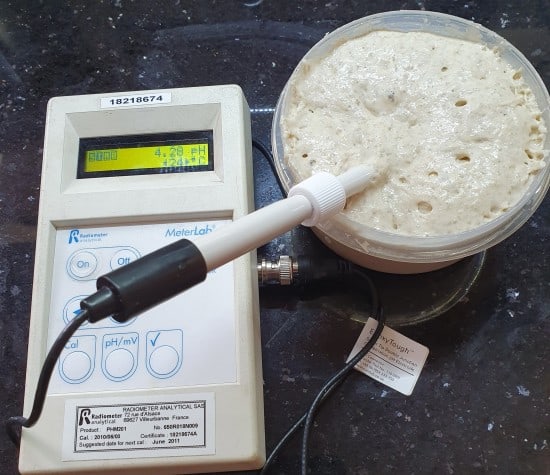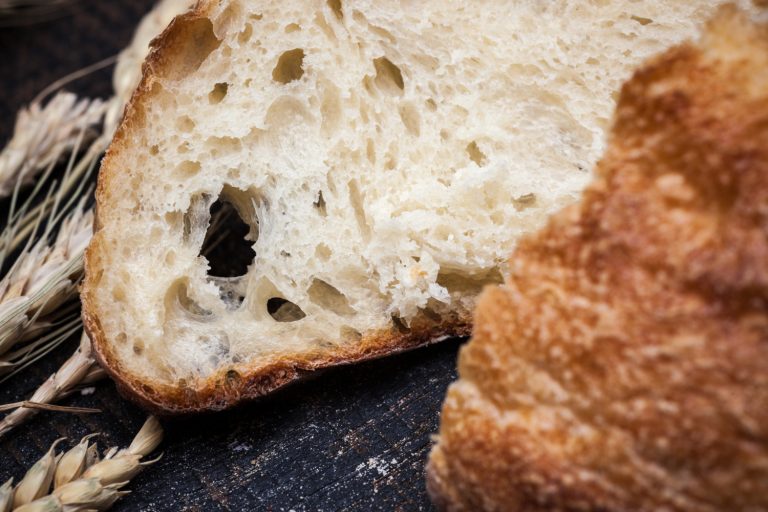Best Sourdough pH Meters: Top Picks for Perfect Fermentation
Perfect sourdough bread requires precise fermentation control. A reliable pH meter is a vital tool for home and professional bakers. Bakers can monitor the acidity levels with a quality sourdough pH meter throughout fermentation and achieve consistent, predictable results. The scientific method eliminates guesswork to determine optimal fermentation levels.
pH level control is significant in sourdough bread’s bulk fermentation and proofing stages. Lactic acid bacteria’s activity and acetic acid production directly affect the bread’s taste, texture, and quality. This piece explores the best pH meters for sourdough baking and explains their features. You will learn to use them effectively to monitor your starter’s activity and dough development.
Top pH Meters for Sourdough Baking
Accurate and reliable pH measurements are crucial in achieving consistent sourdough baking results. Professional and home bakers rely on quality pH meters to perfect their craft. Let me share insights about three exceptional pH meters that have proven their value in bakeries everywhere.
[Image: Hanna Halo 2 Wireless pH Meter in use with sourdough starter]
Hanna Halo 2 Wireless pH Meter
The Hanna Halo 2 represents innovative technology in sourdough pH measurement. This Bluetooth-enabled device connects to smartphones and tablets through the Hanna Lab App. Bakers can track fermentation progress from anywhere. The device delivers precise readings with ±0.01 pH accuracy that helps control bulk fermentation and proofing times.
A specialized bread and dough probe makes testing both liquid starters and firm doughs simple. The spear tip design makes cleaning and maintenance easy. The wireless feature lets bakers monitor their dough without standing over it constantly.
[Image: Apera Instruments PH60S being used to test dough]
Apera Instruments PH60S Spear Tip pH Tester
The PH60S features reliable construction with advanced features designed for food testing. Its replaceable Swiss spear pH probe effectively measures liquid starters and solid dough samples. The device comes with these features:
- Cloud-based data management system
- Multi-device compatibility
- Customizable measurement intervals
- IP67 waterproof rating
Professional bakeries can track fermentation progress on multiple devices through the ZenTest App integration, especially when managing several batches simultaneously.
[Image: Hanna Instruments HI98103 Checker measuring starter pH]
Hanna Instruments HI98103 Checker pH Tester
The HI98103 Checker is a perfect starter pH tester for home bakers. This device delivers reliable readings with ±0.2 pH accuracy despite not having premium features. Its replaceable electrode helps extend the device’s life and provides excellent value when you need occasional measurements.
Key Features Comparison:
| Feature | Halo 2 | PH60S | HI98103 |
|---|---|---|---|
| Accuracy | ±0.01 pH | ±0.01 pH | ±0.2 pH |
| Bluetooth | Yes | Yes | No |
| Probe Type | Spear | Spear | Bulb |
| Data Logging | Yes | Yes | No |
| Battery Life | 1000 hrs | Variable | 3000 hrs |
These meters need simple maintenance steps to work their best:
- Regular calibration using buffer solutions
- Storage in dedicated storage solution between uses
- Gentle cleaning after each use
- Battery level monitoring
- Probe replacement as needed
Your choice between these models depends on your baking needs and usage frequency. Professional bakers might prefer the Halo 2 or PH60S’s advanced features, while home bakers will find the HI98103 perfect for occasional measurements.
Key Features to Consider
[Image: Close-up of digital pH meter display showing accuracy reading]
Bakers must consider several significant features when selecting a pH meter for sourdough baking. These features affect both performance and ease of use. A good understanding of everything in pH meters helps bakers find the perfect tool that matches their needs.
Accuracy and precision
Reliable pH measurement depends on how accurate your meter is. Professional pH meters can measure within ±0.01 pH units, but basic models might be off by ±0.2 pH units. Your readings must be accurate when making sourdough, especially during bulk fermentation, because small pH changes can affect how your dough develops.
High-precision instruments show the same readings when you measure something multiple times, helping you track your fermentation’s progress over time. Temperature compensation features make your readings more accurate by adjusting them based on the surrounding temperature.
[Image: Side-by-side comparison of spear tip and bulb tip probes]
Spear tip vs. bulb tip probes
Probe design substantially affects how well measurements work in sourdough applications:
| Feature | Spear Tip | Bulb Tip |
|---|---|---|
| Penetration | Excellent | Limited |
| Cleaning Ease | High | Moderate |
| Durability | Very Good | Good |
| Cost | Higher | Lower |
| Best For | Firm dough | Liquid starter |
Spear tip probes excel at penetrating firm dough and deliver consistent readings in doughs of all hydration levels. Their design makes cleaning and maintenance simple and vital for food safety compliance. Bulb tip probes cost less and perform better with liquid starters, but they often have trouble with firmer doughs.
Bluetooth connectivity and data logging
Modern pH meters with wireless capabilities reshape the fermentation monitoring scene for bakers. Bluetooth-enabled devices that connect to smartphone apps provide several advantages:
- Up-to-the-minute pH monitoring without constant dough supervision
- Automatic data recording at custom intervals
- Cloud storage to track multiple batches
- Temperature and time correlation data
- Analysis-ready data export options
These features are a great way to get insights during long fermentation periods and help bakers adjust timing and temperature effectively.
[Image: pH meter being fine-tuned with buffer solution]
Ease of calibration and maintenance
Regular maintenance will give accurate readings and extend your pH meter’s lifespan. Professional pH meters need periodic calibration with standard buffer solutions, usually at pH 4.0 and 7.0. The device manual provides a well-laid-out calibration process.
Storage solutions shield sensitive probe elements between uses. Clean probes prevent cross-contamination and keep readings accurate. Advanced models come with automatic calibration reminders and diagnostic tools that warn users about problems before they affect measurements.
Temperature stability during calibration substantially affects accuracy. Modern pH meters feature automatic temperature compensation (ATC) that adjusts readings based on surrounding conditions. This feature proves vital when you monitor sourdough fermentation at different temperatures.
[Image: pH meter being used to measure sourdough starter]
Using pH Meters for Sourdough
[Image: pH meter being inserted into sourdough starter]
Precise pH measurement turns traditional sourdough baking into a science. Bakers who understand the connection between acidity and fermentation can produce consistent results and improve their bread-making process.
Measuring starter acidity
Your sourdough starter should maintain a pH between 3.5 and 4.5 when healthy. A pH meter helps you track your starter’s health and tells you the best times to feed it. Here’s how to measure correctly:
- Ensure the starter is well-mixed
- Clean the pH probe with distilled water
- Insert the probe into the center of the starter
- Wait for the reading to stabilize
- Record the measurement
[Image: Split screen showing pH readings of mature vs young starter]
Temperature affects starter activity and pH readings significantly. You should take measurements when the temperature stays between 68-75°F (20-24°C). The readings become more meaningful when you take them simultaneously in your feeding schedule.
| Starter Stage | Expected characteristics | s |
|---|---|---|
| Just Fed | 5.0 – 6.0 | Fresh flour influence |
| Peak Activity | 3.8 – 4.2 | Maximum gas production |
| Mature | 3.5 – 3.8 | Ready for refreshment |
Monitoring dough fermentation
The pH levels decrease steadily as lactic acid bacteria produce organic acids during bulk fermentation. Bakers can track this progression and determine optimal folding and shaping times with the help of sourdough pH meter readings.
[Image: pH meter measuring bulk fermentation progress]
A baker’s dough monitoring success depends on:
- Regular measurements at consistent intervals
- Temperature compensation considerations
- Clean probe insertion techniques
- Documentation of readings with time and temperature
The dough’s pH typically starts at 6.0 during mixing and drops to about 4.0-4.2 when bulk fermentation ends. This pH decline shows how flavor compounds develop and how organic acids modify the gluten structure.
Determining optimal proofing time
The final proofing stage plays a key role as pH levels drop slower. Expert bakers check pH levels and examine how the dough feels to determine the best time to bake.
[Image: Side-by-side comparison of pH readings during different proofing stages]
Most sourdough breads need a final pH between 3.8 and 4.2 before going to the oven. This range shows you have:
- Good acid levels for flavor
- The right gluten structure
- Proper gas holding ability
- The right mix of acetic and lactic acid
Proofing temperature greatly affects fermentation speed and acid production. Cool temperatures (50-55°F/10-13°C) help produce more acetic acid, while warm temperatures (75-80°F/24-27°C) boost lactic acid production.
Here’s how to measure pH during proofing:
- Put the probe in at a 45-degree angle
- Check several spots
- Keep room temperature in mind
- Write down the time between checks
Pro bakers usually create pH curves for their recipes and track how pH changes. This helps them keep their bread consistent even as seasons change.
[Image: Baker recording pH measurements in production log]
Your pH probe needs proper care to give accurate readings. Here’s what to do between measurements:
- Clean it with distilled water
- Keep it in the right storage solution
- Fine-tune it with standard buffers
- Look at temperature compensation settings
- Keep good maintenance records
Knowing pH patterns helps bakers fix common problems. A high pH usually means the dough hasn’t fermented enough, while a very low pH shows it’s gone too far. Bakers can make better bread by matching pH readings with the bread’s outcome.
Expert bakers examine pH, dough temperature, volume changes, and how the dough feels. This complete approach helps them better understand fermentation and develop a feel for perfect timing at each step.
Conclusion
[Image: Professional baker using pH meter with sourdough]
Scientific pH measurement makes sourdough baking more precise and less about guesswork. Bakers now have unprecedented control over fermentation with modern pH meters, which range from professional-grade wireless devices to reliable entry-level tools. These instruments help achieve consistent results by accurately monitoring critical pH ranges: 3.5-4.5 for starters and 3.8-4.2 for final dough. Thus, each bake becomes more predictable and successful.
Bakers gain deeper insights into fermentation patterns and make better timing decisions through regular pH monitoring. Data logging capabilities and remote monitoring features help professional bakers streamline production schedules and maintain quality across batches. Passionate home bakers and restaurant owners ready to elevate their bread and pizza game can transform their baking with an authentic artisanal sourdough starter from The Yeast We Can Do – email john@theyeastwecando.com to get started with our premium starter. Bakers can achieve exceptional results and consistent quality in their sourdough creations with the right pH meter and knowledge.






